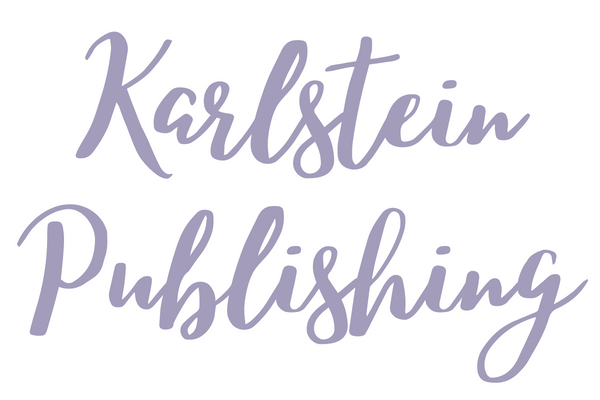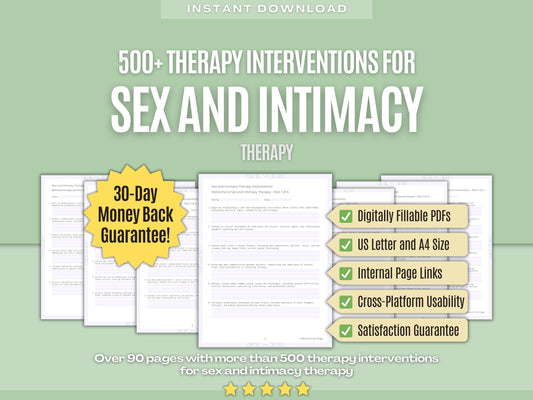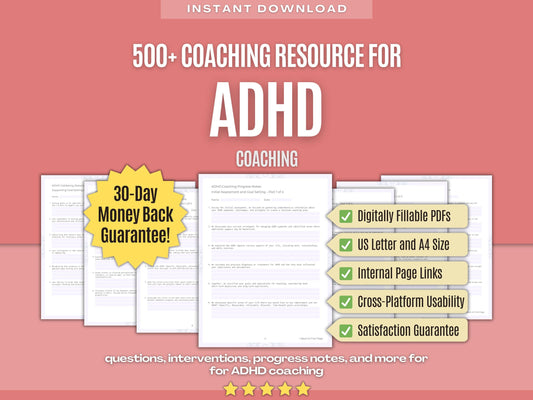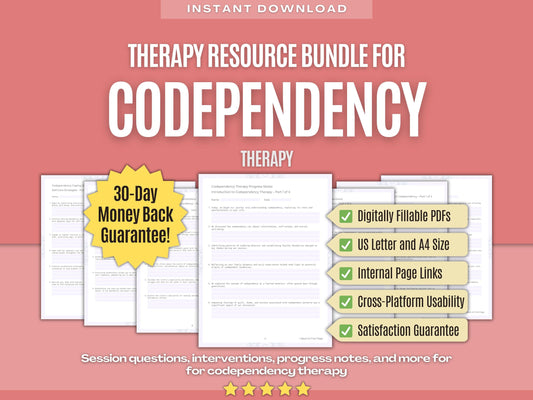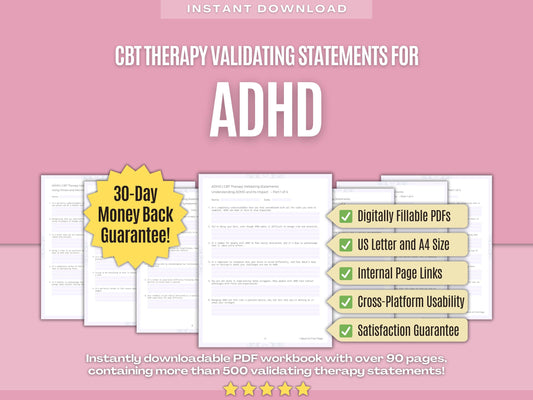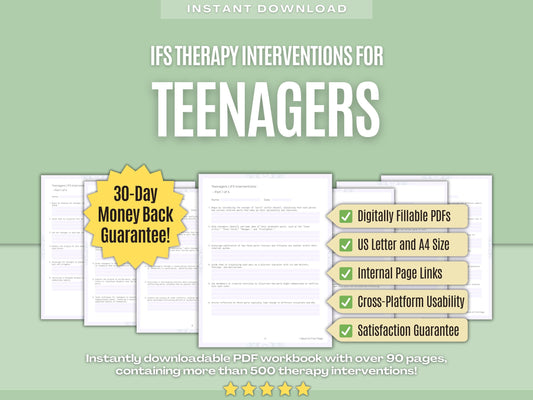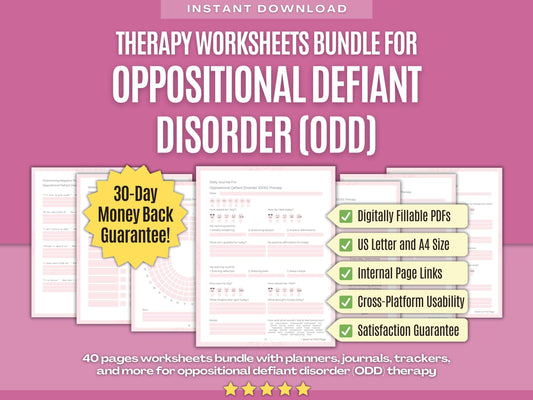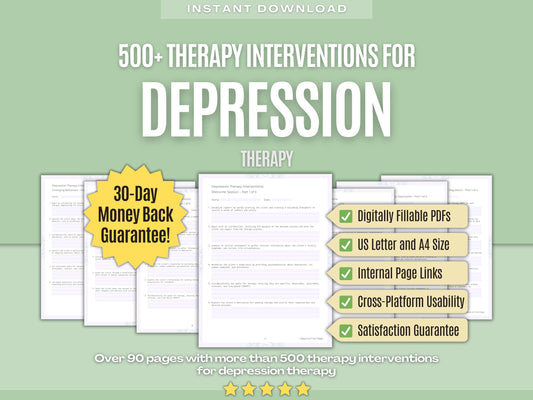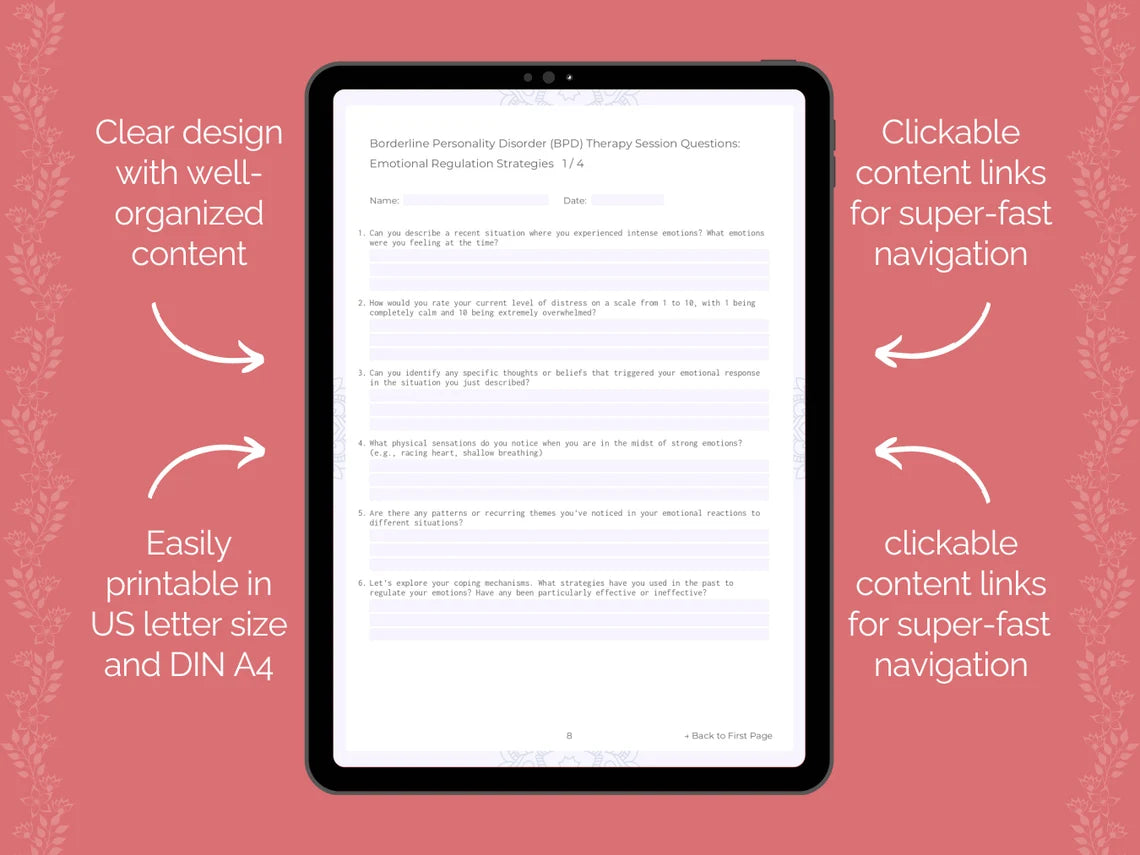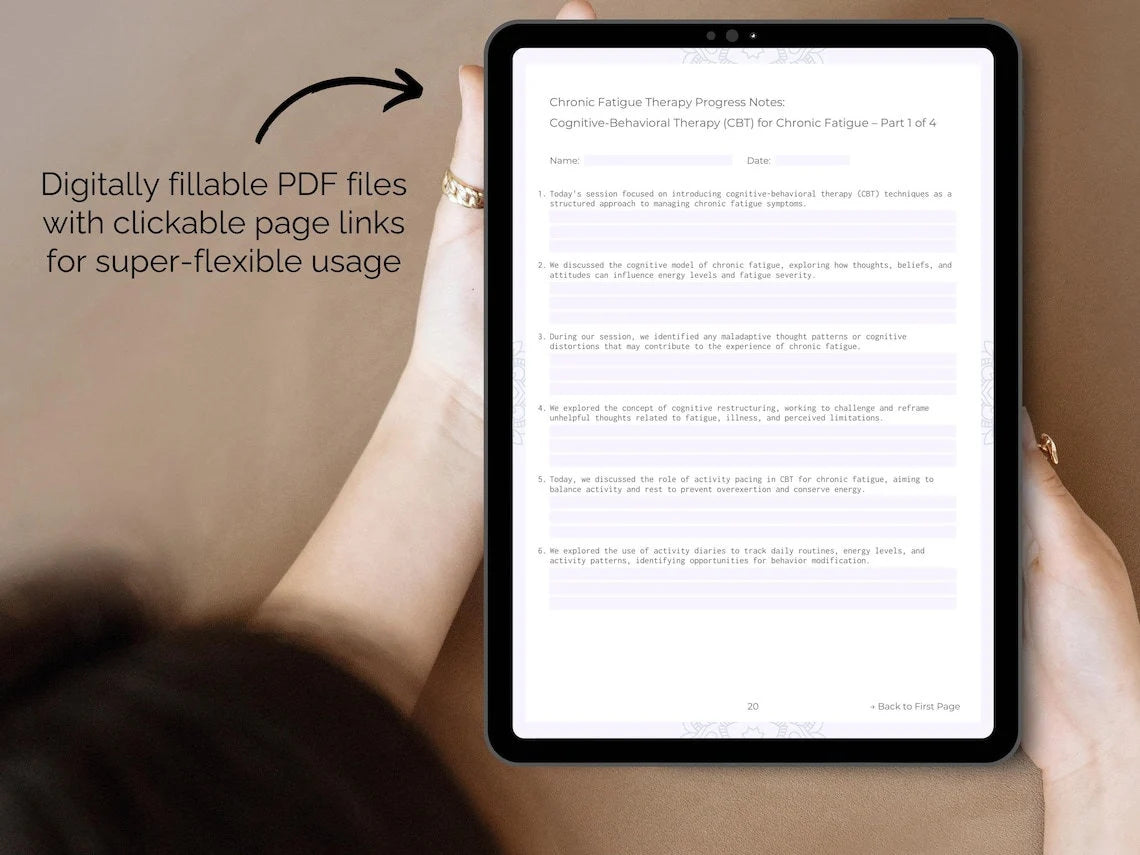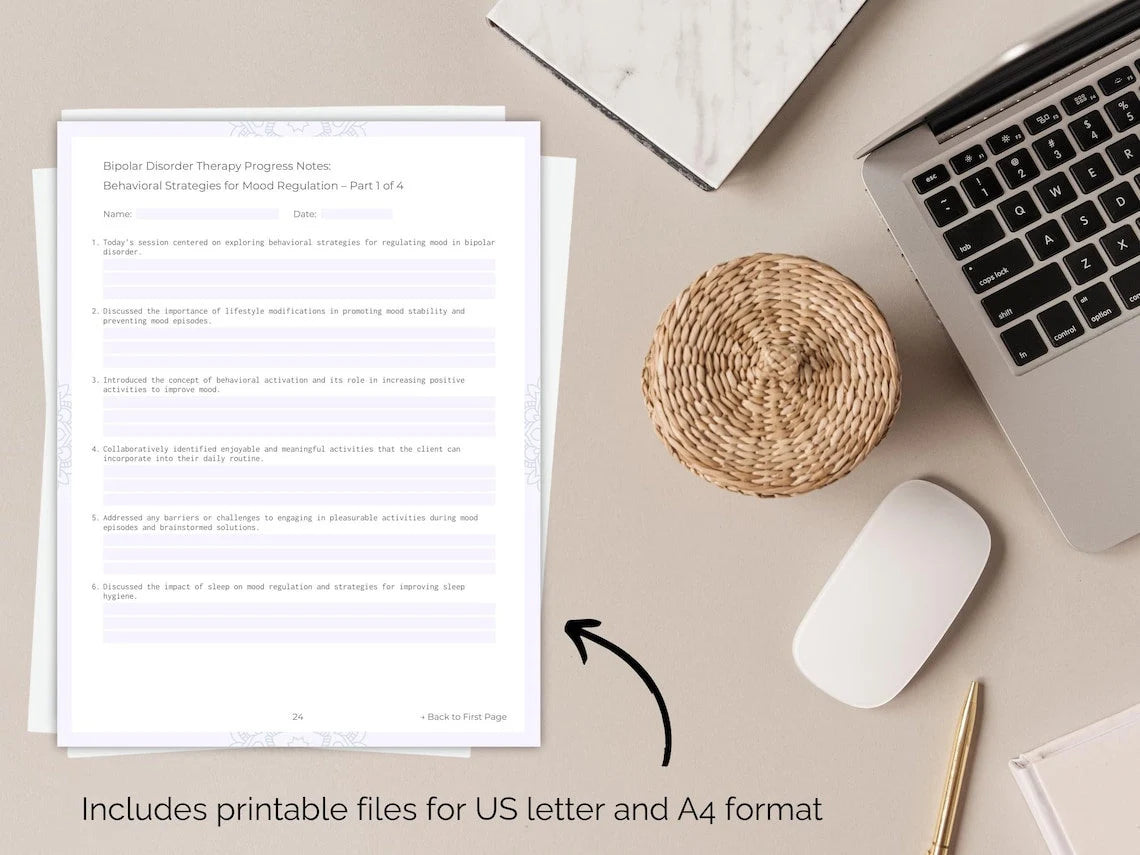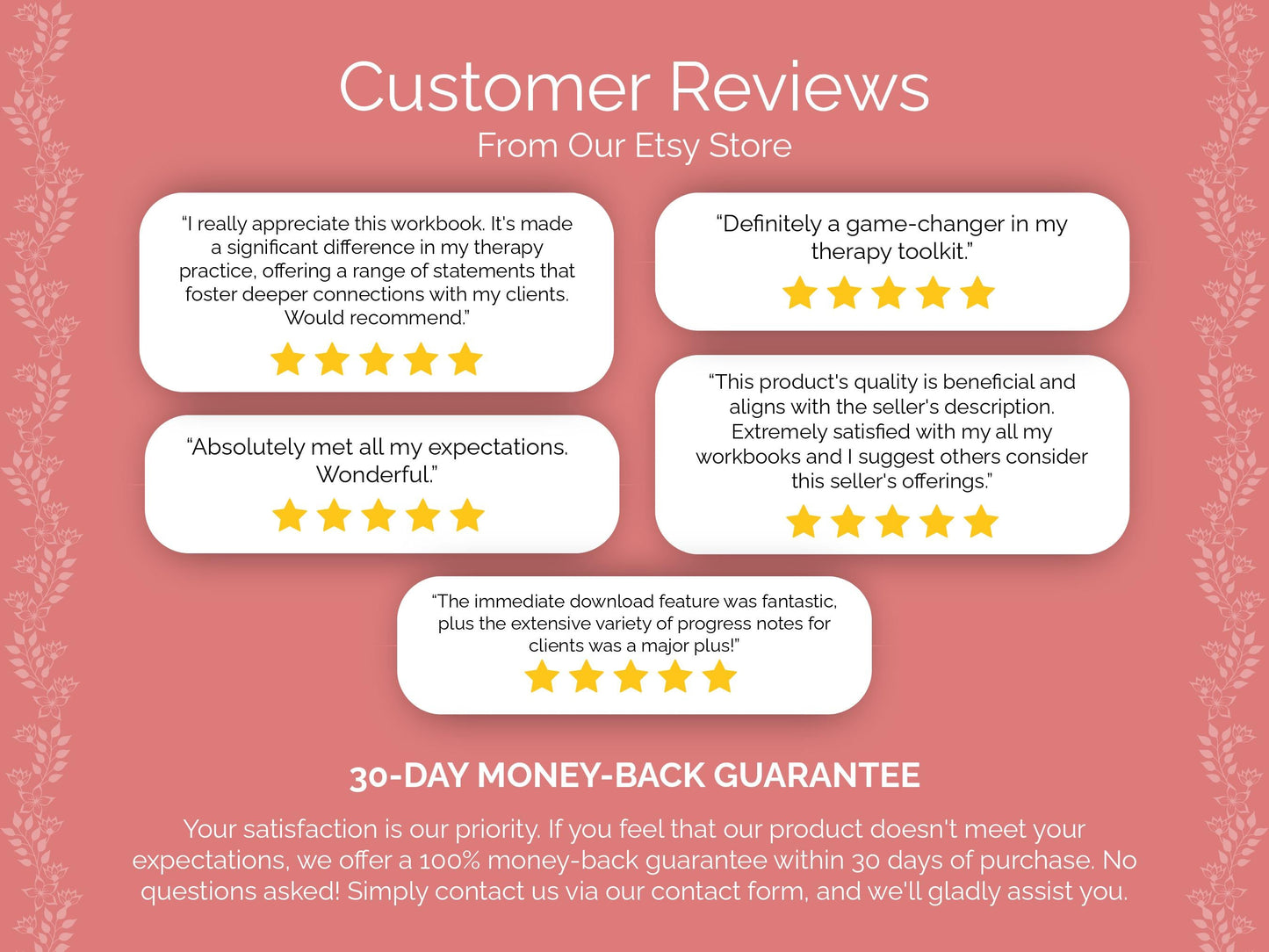Elevate Your Therapy and Guide Your Clients to Inner Healing with Our Anxiety Disorders Therapy Progress Notes! ✨
1. Starting Anxiety Therapy
- Client attended their first therapy session for anxiety, expressing a willingness to address their symptoms and improve their quality of life.
- Conducted a thorough assessment of the client's anxiety symptoms, exploring their frequency, intensity, and impact on daily functioning.
- Explored the client's past experiences and family history to gain insight into potential triggers and perpetuating factors for their anxiety.
- Provided psychoeducation about the neurobiological basis of anxiety and its common manifestations.
- Addressed any misconceptions or concerns the client had about therapy and the treatment process.
- Introduced relaxation techniques such as deep breathing exercises and progressive muscle relaxation to help manage acute anxiety symptoms.
- Explored the client's current coping mechanisms and identified areas for enhancement.
- Addressed any barriers to treatment adherence, such as scheduling conflicts or financial concerns, and discussed potential solutions.
- Discussed the potential role of medication in managing anxiety symptoms, if appropriate, and addressed any questions or concerns.
- Encouraged the client to seek support from friends, family, or support groups outside of therapy.
- Provided reassurance and support to alleviate any apprehensions or doubts the client had about engaging in therapy.
2. Anxiety Disorders Education
- The client attended a session focused on anxiety disorders education, demonstrating an interest in understanding their condition better.
- Discussed the prevalence rates of anxiety disorders and emphasized that they are among the most common mental health conditions worldwide.
- Addressed the genetic and environmental factors that contribute to the development of anxiety disorders, including family history, early life experiences, and stressors.
- Discussed the hallmark symptoms of anxiety disorders, such as excessive worry, irrational fears, avoidance behaviors, and physiological arousal.
- Explained the concept of the anxiety cycle, including the interplay between thoughts, emotions, physical sensations, and behaviors.
- Addressed the stigma surrounding anxiety disorders and encouraged the client to view their condition through a compassionate and non-judgmental lens.
- Provided information about evidence-based treatment approaches for anxiety disorders, including cognitive-behavioral therapy (CBT), exposure therapy, and medication.
- Explained the principles of CBT, emphasizing the focus on identifying and challenging maladaptive thoughts and behaviors.
- Discussed the importance of lifestyle modifications, including regular exercise, healthy diet, adequate sleep, and stress management, in managing anxiety.
- Provided resources for further reading and self-help, including reputable websites, books, and online forums dedicated to anxiety disorders.
- Encouraged the client to track their anxiety symptoms and triggers between sessions to gain a better understanding of their condition.
3. Mindfulness for Anxiety
- During today's session on mindfulness for anxiety, the client demonstrated openness and willingness to explore new coping strategies.
- Discussed the role of mindfulness in anxiety management, emphasizing its effectiveness in reducing rumination, worry, and reactivity.
- Clarified common misconceptions about mindfulness, such as the need to clear the mind of thoughts or achieve a state of relaxation.
- Guided the client through a mindfulness meditation practice, encouraging them to observe their thoughts, emotions, and bodily sensations without attachment or judgment.
- Discussed the concept of the "observer self" in mindfulness, encouraging the client to cultivate a curious and compassionate stance towards their inner experiences.
- Introduced the RAIN (Recognize, Accept, Investigate, Non-identification) mindfulness technique for working with difficult emotions and thoughts.
- Discussed informal mindfulness practices, such as mindful eating, mindful listening, and mindful movement, to incorporate mindfulness into daily activities.
- Explored the client's experiences with mindfulness outside of therapy sessions, encouraging them to reflect on any changes in their awareness or coping with anxiety.
- Discussed the potential role of mindfulness in enhancing interpersonal relationships and communication skills, which can indirectly alleviate anxiety.
- Provided resources for further exploration of mindfulness, including books, apps, and guided meditation recordings.
- Offered validation and support for the client's efforts in integrating mindfulness into their anxiety management toolkit.
4. Dialectical Behavior Therapy (DBT) for Anxiety
- Today's session focused on Dialectical Behavior Therapy (DBT) for anxiety, with the client expressing openness to learning new skills for managing their symptoms.
- Provided psychoeducation about the biosocial theory of emotion dysregulation, highlighting the interaction between biological vulnerability and invalidating environments in the development of anxiety.
- Introduced mindfulness skills as the foundation of DBT, emphasizing the practice of non-judgmental awareness of thoughts, emotions, and sensations in the present moment.
- Addressed any challenges or resistance the client experienced during mindfulness practice, emphasizing the importance of self-compassion and persistence.
- Discussed the concept of radical acceptance, encouraging the client to acknowledge and make peace with reality as it is, rather than fighting against it.
- Addressed maladaptive coping strategies the client may rely on during times of distress, such as avoidance or self-destructive behaviors, and explored healthier alternatives.
- Provided guidance on building mastery and increasing self-confidence through engagement in pleasurable and meaningful activities, even in the presence of anxiety.
- Addressed any barriers to skill acquisition or practice, such as time constraints or difficulty implementing strategies in real-life situations, and collaboratively problem-solved solutions.
- Reviewed progress with skill acquisition and application, acknowledging achievements and addressing any challenges or setbacks encountered.
- Scheduled a follow-up appointment to review progress with DBT skills, reinforce key concepts, and continue working towards treatment goals.
- Reiterated the importance of commitment and consistency in practicing DBT skills, emphasizing that lasting change requires ongoing effort and dedication.
5. Interpersonal Therapy (IPT) for Anxiety in Relationships
- Today's session focused on Interpersonal Therapy (IPT) for anxiety in relationships, with the client expressing a desire to explore how their anxiety impacts their interpersonal interactions.
- Conducted an interpersonal inventory to identify significant relationships in the client's life and explore patterns of interaction that contribute to their anxiety.
- Addressed any recent life events or transitions that may have triggered or exacerbated the client's anxiety symptoms, such as changes in relationships, work, or health.
- Explored the client's communication style and interpersonal patterns, including tendencies towards avoidance, people-pleasing, or conflict avoidance.
- Discussed the role of attachment theory in understanding the client's anxiety within the context of their early relationships and attachment experiences.
- Addressed any relationship conflicts or difficulties the client was experiencing, exploring underlying dynamics and patterns of interaction.
- Encouraged the client to practice active listening and empathy towards others, fostering understanding and connection in their interpersonal interactions.
- Explored the impact of cultural or societal norms on the client's interpersonal relationships and communication style, considering how these factors may influence anxiety.
- Discussed the potential role of social anxiety in the client's interpersonal difficulties, exploring strategies for managing anxiety symptoms in social settings.
- Addressed any avoidance behaviors the client may engage in to cope with social anxiety, exploring alternative ways of approaching feared situations.
- Scheduled a follow-up appointment to review progress with IPT techniques, reinforce key insights, and continue working towards interpersonal goals.
6. Emotion-Focused Therapy (EFT) for Anxiety
- Today's session focused on Emotion-Focused Therapy (EFT) for anxiety, with the client expressing a willingness to explore their emotional experiences and their connection to anxiety symptoms.
- Discussed the role of underlying emotions in driving anxiety symptoms, exploring how unmet emotional needs and unresolved emotional conflicts may contribute to anxiety.
- Addressed any emotional avoidance or suppression strategies the client may use to cope with anxiety, exploring the impact of these strategies on their emotional well-being.
- Explored the client's emotional memories and experiences related to anxiety triggers, facilitating emotional processing and expression in a safe therapeutic environment.
- Introduced emotion-focused interventions such as empathic exploration, empty chair work, or two-chair dialogues to facilitate emotional expression and resolution.
- Addressed any resistance or ambivalence the client may have towards experiencing or expressing certain emotions, exploring the reasons behind their emotional blocks.
- Discussed the importance of self-compassion and self-care in managing anxiety, emphasizing the role of nurturing and supportive self-talk in soothing emotional distress.
- Encouraged the client to express their emotional needs and assert their boundaries in relationships, promoting greater emotional intimacy and connection.
- Addressed any unresolved grief or trauma that may be contributing to the client's anxiety symptoms, facilitating emotional processing and healing in therapy.
- Scheduled a follow-up appointment to review progress with EFT techniques, reinforce key insights, and continue exploring and processing emotions related to anxiety.
- Reiterated the importance of patience and persistence in the emotional healing process, emphasizing that lasting change takes time and effort.
7. Psychodynamic Approaches for Deep Anxiety Issues
- Today's session delved into psychodynamic approaches for deep anxiety issues, with the client expressing readiness to explore the underlying unconscious factors contributing to their anxiety.
- Discussed the concept of anxiety as a manifestation of internal psychic conflict, exploring how unresolved conflicts between instinctual drives, ego defenses, and superego demands contribute to anxiety.
- Addressed any unresolved conflicts or traumas from childhood that may be contributing to the client's anxiety symptoms, exploring how these past experiences continue to influence their emotional life.
- Encouraged the client to engage in free association exercises, dream analysis, or other psychodynamic techniques to access unconscious material and gain insight into the roots of their anxiety.
- Explored the client's relationships with significant others, considering how early object relations and attachment patterns may influence current interpersonal dynamics and contribute to anxiety.
- Addressed any transference or countertransference dynamics that emerged in the therapeutic relationship, exploring their relevance to the client's anxiety patterns and relational struggles.
- Encouraged the client to explore the symbolic meanings of their anxiety symptoms, considering how these manifestations may reflect underlying psychological conflicts or unmet needs.
- Offered interpretation and insight into the client's unconscious dynamics, facilitating greater self-awareness and understanding of their anxiety patterns.
- Addressed any existential or spiritual concerns the client may have about the nature of existence and their place in the world, exploring how these existential themes may intersect with their anxiety symptoms.
- Encouraged the client to engage in reflective journaling or creative expression as a means of accessing and processing unconscious material outside of therapy sessions.
- Offered additional resources for further exploration of psychodynamic concepts and techniques, including books, articles, and workshops.
8. Music Therapy for Soothing Anxiety
- Today's session centered on music therapy for soothing anxiety, with the client expressing interest in exploring the therapeutic potential of music to alleviate their anxiety symptoms.
- Discussed the physiological and psychological effects of music on the brain and body, including its ability to modulate heart rate, respiration, and neurotransmitter activity.
- Addressed any preferences or aversions the client may have regarding musical genres, instruments, or styles, tailoring the music therapy interventions to their individual tastes and preferences.
- Provided a selection of calming and soothing music for the client to listen to during the session, taking into account their preferences and emotional needs.
- Encouraged the client to explore their emotional responses to the music, inviting them to notice any shifts in mood, tension, or physical sensations as they engage with the music.
- Explored the use of music improvisation or composition as a means of self-expression and emotional release, allowing the client to create their own musical narratives to soothe anxiety.
- Addressed any barriers or challenges the client may encounter in integrating music therapy into their daily routine, exploring ways to overcome obstacles and foster consistency.
- Offered validation and empathy for the client's struggles with anxiety, affirming the therapeutic value of music as a tool for self-care and emotional healing.
- Encouraged the client to experiment with different types of music and relaxation techniques to determine what works best for them in managing anxiety symptoms.
- Offered additional resources for further exploration of music therapy concepts and techniques, including books, articles, and online resources.
- Encouraged the client to embrace music as a source of comfort, inspiration, and resilience on their journey towards healing from anxiety.
9. Concluding Anxiety Therapy Sessions
- Today's session marked the conclusion of our anxiety therapy sessions, with the client expressing gratitude for the progress made and reflecting on their journey towards healing.
- Conducted a comprehensive review of the strategies and techniques learned in therapy, discussing which interventions were most helpful in managing anxiety symptoms and promoting well-being.
- Encouraged the client to reflect on the insights gained and lessons learned throughout the therapy process, recognizing the personal growth and self-discovery that has taken place.
- Addressed any fears or concerns the client may have about ending therapy, reassuring them that they have developed the skills and resilience necessary to navigate challenges independently.
- Offered validation and affirmation for the client's courage and commitment to their own healing journey, recognizing the strength it takes to confront and overcome anxiety.
- Offered additional resources for further support and exploration, including books, support groups, online resources, and community resources.
- Encouraged the client to maintain open lines of communication and reach out for support if they ever feel overwhelmed or in need of assistance.
- Offered reassurance that ending therapy does not mean the end of growth or support, but rather a transition to a new phase of self-discovery and personal development.
- Explored any potential challenges or obstacles the client may face in maintaining progress, discussing strategies for overcoming setbacks and staying resilient in the face of adversity.
- Offered validation for the client's emotions as they navigate the transition out of therapy, acknowledging that endings can be bittersweet but also signify growth and progress.
- Encouraged the client to take time to celebrate their achievements and acknowledge the hard work they have put into their own healing journey.
10. Final Reflections on Anxiety Management
- Today's session marked the final reflections on anxiety management, with the client expressing gratitude for the therapeutic journey and reflecting on their progress in managing anxiety.
- Conducted a comprehensive review of the coping strategies and skills learned in therapy, discussing which techniques were most effective in managing anxiety symptoms.
- Addressed any fears or concerns the client may have about maintaining progress after therapy, discussing strategies for integrating therapeutic skills into daily life.
- Discussed the importance of self-compassion and self-care in managing anxiety, emphasizing the need for kindness and patience towards oneself during times of stress.
- Explored the client's plans for continuing their journey towards anxiety management, discussing strategies for staying proactive and seeking support when needed.
- Scheduled a follow-up appointment or check-in session to monitor progress and provide ongoing support as needed, ensuring a smooth transition out of therapy.
- Encouraged the client to celebrate their achievements and acknowledge the progress they have made in managing anxiety, no matter how small.
- Expressed gratitude for the client's trust in the therapeutic process and their willingness to engage in the work of managing anxiety.
- Offered reassurance that ending therapy does not mean the end of growth or support, but rather a transition to a new phase of self-discovery and personal development.
- Encouraged the client to continue practicing self-care and self-compassion, recognizing the importance of prioritizing their own well-being.
- Expressed hope that the client will carry the insights and skills gained in therapy forward into their future endeavors, empowering them to live a life of fulfillment and purpose.
We hope that our therapy progress notes for Anxiety Disorders therapy will help you to elevate your therapy practice and guide your clients to inner healing! Do you need more therapy progress notes for Anxiety Disorders therapy? Find them all in our Digital Workbook! Or do you have any questions or suggestions for us? Please feel free to contact us at any time!
